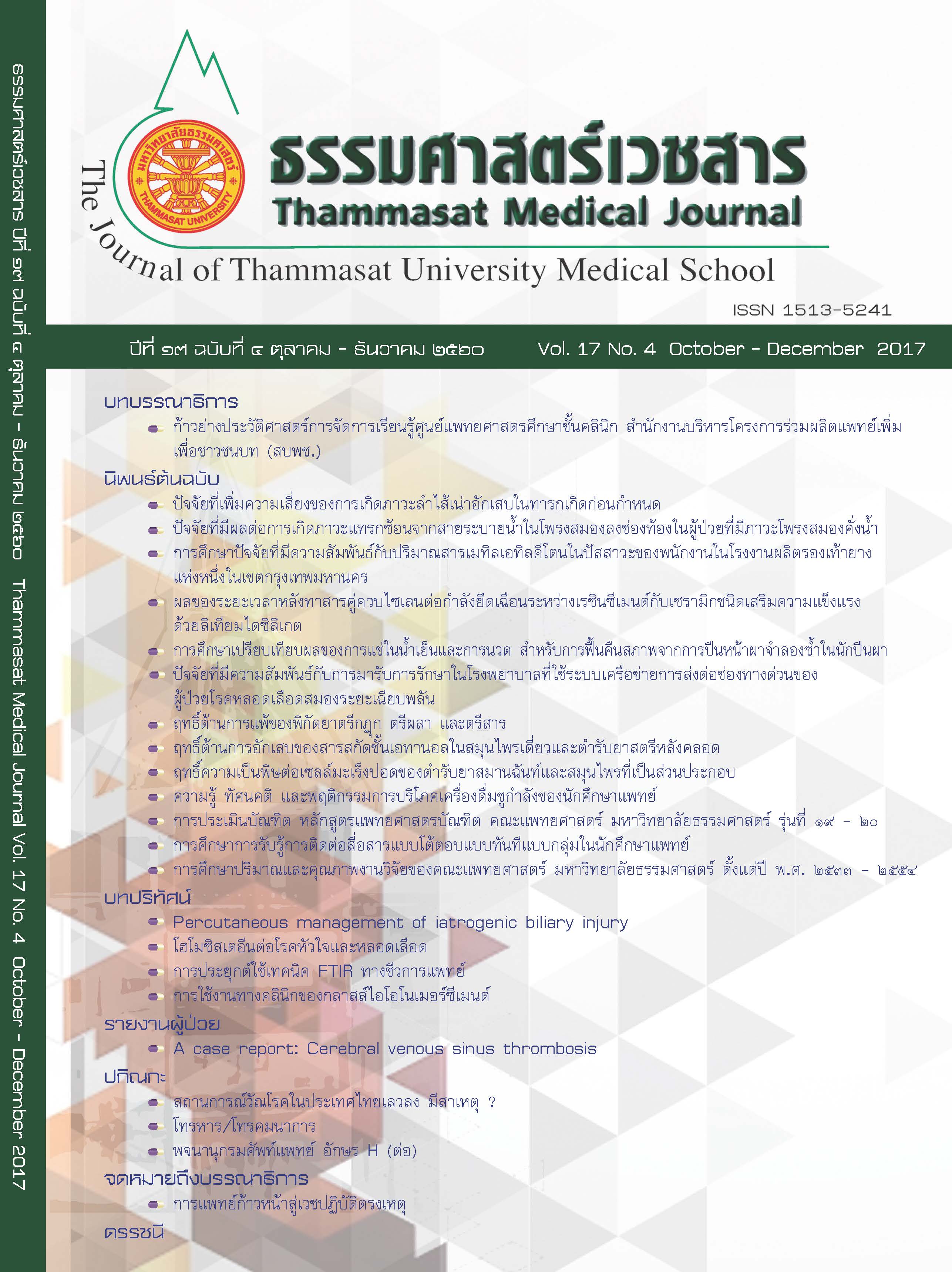Percutaneous management of iatrogenic biliary injury
Keywords:
Biliary injury, Percutaneous cholangioplasty, Biliary stent, ภาวะบาดเจ็บของท่อทางเดินน้ำดี, บอลลูนขยายท่อน้ำดี, ท่อค้ำยันบริเวณท่อทางเดินน้ำดีAbstract
Iatrogenic biliary injuries are infrequent complications after hepatobiliary surgery or intervention, but potentially harmful. The injuries are mainly divided into biliary stricture and bile leak. Surgical correction is the definite treatment, but many limitations including inappropriate patient’s conditions, difficult surgical approach due to extensive adhesion and the availability of experience hepatobiliary surgeons. Nonoperative (endoscopic or percutaneous) management performs well in such patients. However, endoscopic treatment is sometimes impossible in patients with bilioenteric anastomosis and sometimes does not do well in patients with hilar lesions. Percutaneous management plays an important role in both diagnosis and treatment. There are many common strategies including percutaneous transhepatic cholangiography (PTC), percutaneous transhepatic biliary drainage (PTBD), percutaneous biliary balloon dilation (PBBD), percutaneous biliary stent placement, and percutaneous drainage of fluid collection or biloma. Several standard and advanced techniques, outcomes and complications of these procedures are reviewed in this study. Percutaneous management is an effective procedure for iatrogenic biliary injuries with acceptable complication rates.
บทคัดย่อ
ภาวะบาดเจ็บของท่อทางเดินน้ำดีเป็นภาวะแทรกซ้อนที่แม้จะพบได้ไม่บ่อยจากการทำหัตถการหรือการผ่าตัดบริเวณตับและทางเดินน้ำดี แต่มีความสำคัญและเป็นอันตรายต่อผู้ป่วย ภาวะท่อทางเดินน้ำดีบาดเจ็บสามารถแบ่งได้เป็น ๒ กลุ่มใหญ่ ๆ คือ ท่อน้ำดีตีบตันและท่อน้ำดีรั่ว การรักษาด้วยการผ่าตัดซ่อมแซมทำให้ผู้ป่วยหายได้ แต่การผ่าตัดมักมีข้อจำกัด เช่น ภาวะผู้ป่วยไม่เหมาะสมต่อการผ่าตัด มีผังผืดมากบริเวณที่ผ่าตัด หรือขาดศัลยแพทย์ผู้เชี่ยวชาญด้านการผ่าตัดทางเดินน้ำดี การรักษาโดยไม่ผ่าตัด ได้แก่ การทำหัตถการผ่านการส่องกล้องหรือผ่านทางผนังหน้าท้อง สามารถทำได้ในผู้ป่วยเหล่านี้ อย่างไรก็ตามการส่องกล้องบางครั้งก็พบข้อจำกัด เช่น กรณีผู้ป่วยเคยทำการตัดต่อลำไส้กับท่อน้ำดีมาก่อน หรือรอยโรคอยู่บริเวณขั้วตับ การทำหัตถการผ่านทางผนังหน้าท้องจึงมีความสำคัญทั้งในแง่ของการวินิจฉัยและการรักษา หัตถการที่ทำบ่อย ได้แก่ การฉีดสารทึบรังสีเข้าไปในท่อทางเดินน้ำดีเพื่อการวินิจฉัย การใส่สายระบายน้ำดีผ่านทางผนังหน้าท้อง การใช้บอลลูนขยายท่อน้ำดีผ่านทางผนังหน้าท้อง การใส่ท่อค้ำยันบริเวณท่อทางเดินน้ำดีที่ตีบหรือรั่ว และการใส่สายระบายน้ำดีที่ขังอยู่ในตับหรือช่องท้อง บทความนี้ได้รวบรวมข้อมูลเกี่ยวกับวิธีการ ผลลัพธ์ และภาวะแทรกซ้อนของการทำหัตถการต่างๆ ผ่านทางผนังหน้าท้อง ซึ่งพบว่ามีประสิทธิภาพดีในการรักษาผู้ป่วยที่มีภาวะบาดเจ็บของท่อทางเดินน้ำดีและมีภาวะแทรกซ้อนน้อย



